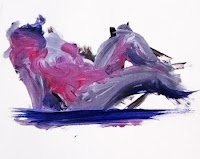 At the moment I am exploring the borderline between figuration and abstraction using the human form as a subject; I've been painting from a lovely live model and from a couple of photos of fascinating Maltese neolithic sculptures which demonstrate a completely different view of the female form from the western European tradition.
At the moment I am exploring the borderline between figuration and abstraction using the human form as a subject; I've been painting from a lovely live model and from a couple of photos of fascinating Maltese neolithic sculptures which demonstrate a completely different view of the female form from the western European tradition.The paintings are just quick studies, so sometimes I get an intentional effect, sometimes I get a happy accident, which I can use later, and sometimes I get a total car crash. I have several issues that lead to dangerous road conditions.
I really want to develop a free, vigorous and improvisational style - this means lots of paint, which is expensive. So I use cheap acrylic paint, which does not mix well, has a sort of yuckky texture and pretty garish tacky colours. So far so iffy. I have managed to mess around using PVA and mixing in relatively small quantities of better colours to improve things. Also I am painting on paper, which inevitably tends to wrinkle up with the paint.
The real problem is keeping an iron control of myself with regard to composition and colour palette while really letting go with the palette knife, brushes or whatever. I think this is a classic for all painters. Basically, if you keep thinking 'what an interesting colour - I can just add that in here' and get carried away, you end up with a sort of browny, blacky mess.
 That's what happened to my neolithic goddesses. I didn't think clearly enough about the colour palette in the beginning, and then having made my decisions I didn't stick to them - as an excuse I was under time pressure and I carried on painting feeling it was all running away with me. I was into an uncontrollable skid.
That's what happened to my neolithic goddesses. I didn't think clearly enough about the colour palette in the beginning, and then having made my decisions I didn't stick to them - as an excuse I was under time pressure and I carried on painting feeling it was all running away with me. I was into an uncontrollable skid. I include my goddesses as a dire warning to all painters in danger of driving on to disaster. Remember, the main technical problem with any car is the nut behind the wheel.






